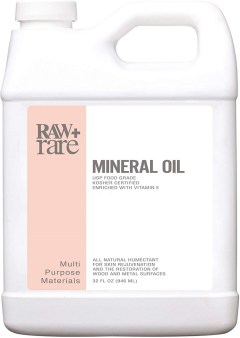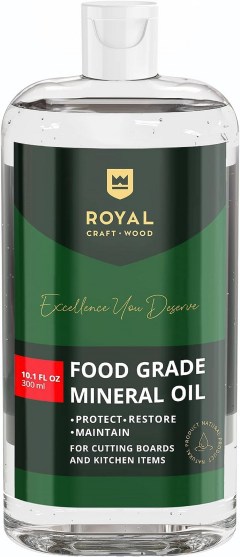BestReviews is reader-supported and may earn an affiliate commission. Details

Safe to use on any wooden products in the kitchen for a noteworthy restoration.
Safe to use on any wooden products in the kitchen for a noteworthy restoration.
Use this on wood utensils, cutting boards, or bowls to protect the material from water absorption. Made in the U.S. Materials are safe to use. Comes in a generous 64-ounce bottle.
Some quality control issues with damaged bottle caps and broken seals.

Great price per ounce for a large bottle that's the perfect size for a busy kitchen.
Great price per ounce for a large bottle that's the perfect size for a busy kitchen.
Excellent quality and food-grade. Safe to use on nearly any item in the kitchen. Works to restore wooden utensils or cutting boards by preventing water absorption. Enriched with vitamin E, so it's safe on the skin.
Consistency isn't uniform from bottle to bottle; it may be watery.

Delivers excellent protection for wooden kitchen products in an easy-to-handle size.
Delivers excellent protection for wooden kitchen products in an easy-to-handle size.
The size of this small 8-ounce squeeze bottle allows you to handle it easily and store it in almost any cupboard. Prevents wooden utensils and cutting boards from soaking up food odors or water. Made in the U.S.
A little pricier per ounce than some other brands. Small bottle won't last long.

This all-natural, fragrance-free option contains a single ingredient and can be used for multiple purposes.
This all-natural, fragrance-free option contains a single ingredient and can be used for multiple purposes.
100% pure. Can be used to condition wood, polish stainless steel, protect metals from rust, remove stickers from surfaces, and even moisturize the skin. Free from any fillers, fragrances, or preservatives. Affordable price.
Only available in a large 1-gallon bottle.

This product is worth considering if you are looking for mineral oil that will make your cutting boards and other wooden items look like new.
This product is worth considering if you are looking for mineral oil that will make your cutting boards and other wooden items look like new.
Food-grade mineral oil that's made with quality natural ingredients. Does a good job restoring and protecting the finish of different types of wood, including bamboo. Ideal for wood cutting boards, butcher blocks, utensils, and more.
Several customers received bottles that leaked in the packaging during delivery.

We recommend these products based on an intensive research process that's designed to cut through the noise and find the top products in this space. Guided by experts, we spend hours looking into the factors that matter, to bring you these selections.

List all of the care products you can use on your skin, hair, cast iron pan, wooden cutting board, carving knife, and garden tools. It’s a safe bet that it’s a short list, but one thing that is on that list is food-grade mineral oil.
Also known as white oil, food-grade mineral oil is a multipurpose lubricant that has no taste, no color, and no odor. It is nontoxic, stable at room temperature, and doesn’t spoil. Food-grade mineral oil has many pharmaceutical, industrial, and personal care applications. It smooths, lubricates, softens, restores moisture, and protects surfaces, and food-grade mineral oil is pure enough to use in the kitchen and on your body.

Mineral oil is made up of open-chain hydrocarbons and is a byproduct of petroleum distillation. It’s important to note that not all mineral oil is safe for human consumption. There are three types of mineral oil:
Paraffinic: This mineral oil contains paraffin wax. It’s used as a lubricant, it resists oxidation, and it’s used in the cosmetics, paper, textile, and rubber industries. This is the type of mineral oil discussed here.
Naphthenic: This mineral oil contains no paraffin. It is used in manufacturing.
Aromatic: This mineral oil is used in the processing of rubber for tires.
This type of mineral oil is highly refined, colorless, odorless, flavorless, and safe for human consumption. It is approved by the U.S. Food and Drug Administration for cosmetic and personal care uses as well as a food additive. It is also a nondrying oil that will not solidify (polymerize) over time when exposed to air. Unlike vegetable oil, it won’t go rancid, so it will last a long time if stored properly.

You might be surprised by the variety of uses for this versatile oil.
Knives, high temperatures, soap, and water can all wreak havoc on wooden surfaces as they begin to wear out, grow dull, and warp. Mineral oil penetrates wood to protect it from water damage, prevent it from drying, cracking, or warping, and restore the finish. The oil brings out the grain and hydrates the wood. It has no smell or flavor, which is desirable for many applications in the kitchen. A treated cutting board prevents liquids like juice or blood from penetrating the wood, which means fewer germs and bacteria.
Use it to restore bamboo and other wooden cutting boards, butcher blocks (which need a low-viscosity oil that penetrates deeply), cheese servers, (unvarnished) wooden tables and islands, salad bowls and servers, rolling pins, pizza peels, serving trays, and outdoor wooden furniture, such as teak.
Cast iron: Use food-grade mineral oil to season cast iron cookware by rubbing a small amount into the hot pan.
Blades: Rub it on metal knives, razor blades, and kitchen shears to prevent rust.
Appliances: Lubricate a meat grinder or food slicer.
Stainless steel: Polish stainless steel appliances and counters for a streak-free, food-safe, nonsticky barrier that doesn’t evaporate and helps keep the surfaces from collecting germs and bacteria.
Steel tools: Clean, condition, and winterize your metal gardening tools.
Skin: Mineral oil is a humectant, which means it helps skin retain water. Use it to treat dry, cracked, or sensitive skin or conditions like eczema or psoriasis. It is noncomedogenic, so it won’t clog pores. Mineral oil can treat some scalp conditions such as dandruff and cradle cap. Food-grade mineral oil is a fragrance-free baby oil substitute for use on diaper rash.
Hair: Rub a couple of drops of mineral oil in your hands and smooth into hair to tame flyaway frizz.
Body: Mineral oil has long been used as a natural laxative to help soften stool.
Use food-grade mineral oil to develop a rich patina and enhance the beauty of soapstone sinks and countertops. The oil will also help granite countertops darken evenly, while other types of oil like citrus or linseed can cause granite to discolor. Many products made specifically for counters include mineral oil. Use it to refurbish and seal marble and slate, too.
Use mineral oil to remove latex or oil paint from skin or stickers from surfaces. Use it to remove oil-based makeup. Some consumers have even used it to remove tile adhesive by applying a layer of oil, letting it sit for half an hour and then scraping up the glue.

You will find some food-grade mineral oil that contains added ingredients, such as vitamin E, or added fragrance from essential oils, such as rosemary, lemon, or lavender. While a lavender scent may be fine for the mineral oil you use to remove eye makeup or rub on your skin, it may not be appropriate for use on your cutting board.
Look for assurances of quality with labels like USP Verified, which tells you that the product contains the ingredients on the label, or NSF Certified, which tells you that the producer of the mineral oil uses raw materials that are safe and approved by the FDA.
You can also find food-grade mineral oil labeled as organic, kosher, and/or not tested on animals if those qualities are important to you.
You can find containers of food-grade mineral oil that hold from 8 to 128 fluid ounces. There are squeeze bottles, aluminum (nonaerosol) spray bottles, and bottles with a pump dispenser to make it easy to get the right amount. Note that if you buy in bulk, the large jugs are harder to use, especially if you only want a small amount of oil at a time. If you want a large jug, look for one with an ergonomic handle for easier gripping and carrying.
Store your food-grade mineral oil in a cool, dry cupboard or other darkened area out of direct sunlight.
Cutting board cleaner: Howard Products Cutting Board Cleaner
This liquid soap, made especially for cutting boards and other wooden items in the kitchen, uses coconut soap and lemon oil to clean the wood and neutralize odors without the use of harsh chemicals.
Kitchen knives: Mercer Culinary Renaissance Knife Block Set
Show off your beautifully oiled knives in this clear tempered-glass block. The set of six high-carbon steel kitchen knives for all your slicing and dicing needs are NSF Certified.
Food-grade mineral oil costs about $1 per ounce in smaller bottles of 8 to 16 ounces. If you want to buy in bulk, such as a 32-ounce jug, you’ll pay about half that, around $0.45 per ounce. Since mineral oil doesn’t go bad if you store it properly, it’s okay to stock up if you use it often.
Safety first. Do not apply mineral oil to open wounds, including cuts and burns. If you get mineral oil in your eyes, rinse your eyes immediately and get medical help. Inhaling mineral oil can irritate the lungs.
Care for your cuticles. During your next home manicure, massage a little mineral oil into your cuticles to help soften and condition the skin.
Do a spot check on wood first. Rub a little mineral oil in an inconspicuous place. Some furniture may have a coating or finish that prevents the oil from absorbing into the wood.
Beautify your wooden kitchen utensils and surfaces. Apply mineral oil to cutting boards and other frequently used surfaces after every few washes or every few weeks. Wash the board, apply a generous amount of oil, and let it absorb for a couple of hours. If the wood is very dry, you might need to reapply the oil several times over 24 hours. Wipe off the excess oil. If desired, apply a cutting board wax to protect the finish.
Do not ingest mineral oil within two hours of a meal. It can interfere with vitamin absorption. Consult your doctor before taking mineral oil as a laxative.

Q. Can’t I just use olive oil or corn oil on my cutting board?
A. No. You should never use any type of vegetable oil to maintain your cutting board, butcher block, or any other wooden items you use with food. These types of oil turn rancid, which can impart bad smells and tastes to the food prepared on the board or in that nice wooden salad bowl. They also get sticky, which is not a desirable quality in a cutting board or salad bowl.
Q. It’s oil! Won’t mineral oil cause my skin to break out?
A. While mineral oil can cause problems for some people, for most people it shouldn’t. Cosmetic- or pharmaceutical-grade mineral oil has been found to be non-comedogenic, so it won’t clog pores.
Q. Can I put my wooden cutting board in the dishwasher?
A. Only if you don’t like it. The high temperature and water will damage the board, perhaps breaking it apart if the board is made up of pieces that are glued together. To clean your wooden cutting board, use hot water, a bit of dish soap, and a soft brush. Don’t immerse the board in the water. Wipe the board with a clean towel and stand it up lengthwise to dry. There are also special soaps made from olive oil, lemon oil, coconut oil, and other ingredients that will safely clean and help maintain the wooden items in your kitchen.
Get emails you’ll love.
Learn about the products you’re wondering if you should buy and get advice on using your latest purchases.
